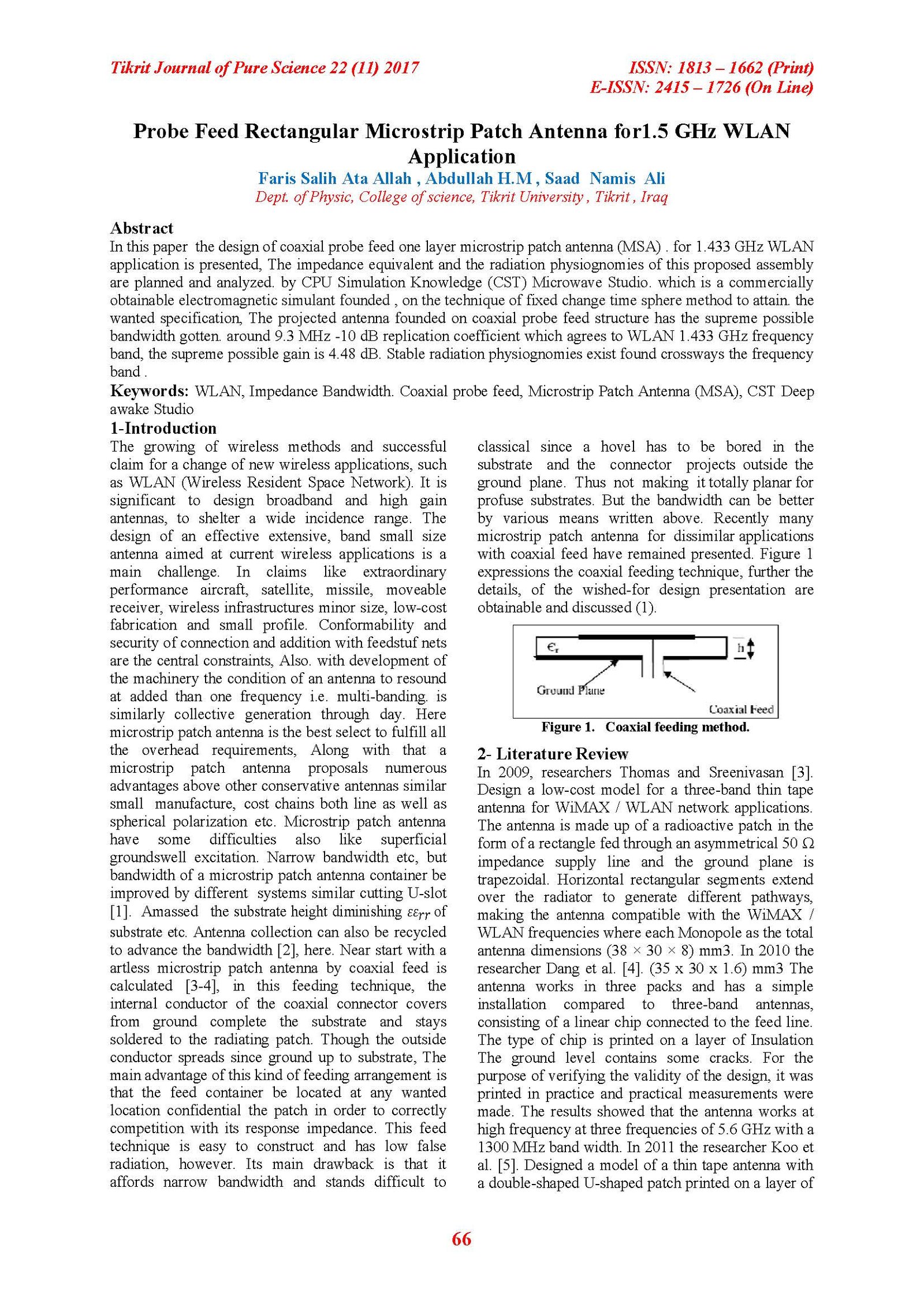Probe Feed Rectangular Microstrip Patch Antenna for1.5 GHz WLAN Application
Main Article Content
Abstract
In this paper the design of coaxial probe feed one layer microstrip patch antenna (MSA) . for 1.433 GHz WLAN application is presented, The impedance equivalent and the radiation physiognomies of this proposed assembly are planned and analyzed. by CPU Simulation Knowledge (CST) Microwave Studio. which is a commercially obtainable electromagnetic simulant founded , on the technique of fixed change time sphere method to attain. the wanted specification, The projected antenna founded on coaxial probe feed structure has the supreme possible bandwidth gotten. around 9.3 MHz -10 dB replication coefficient which agrees to WLAN 1.433 GHz frequency band, the supreme possible gain is 4.48 dB. Stable radiation physiognomies exist found crossways the frequency band .
Article Details

This work is licensed under a Creative Commons Attribution 4.0 International License.
Tikrit Journal of Pure Science is licensed under the Creative Commons Attribution 4.0 International License, which allows users to copy, create extracts, abstracts, and new works from the article, alter and revise the article, and make commercial use of the article (including reuse and/or resale of the article by commercial entities), provided the user gives appropriate credit (with a link to the formal publication through the relevant DOI), provides a link to the license, indicates if changes were made, and the licensor is not represented as endorsing the use made of the work. The authors hold the copyright for their published work on the Tikrit J. Pure Sci. website, while Tikrit J. Pure Sci. is responsible for appreciate citation of their work, which is released under CC-BY-4.0, enabling the unrestricted use, distribution, and reproduction of an article in any medium, provided that the original work is properly cited.
References
[1] X. L. Sun, S.W. Cheung, and T. I. Yuk “Compact
Dual-Band Monopole Antenna for 2.4/3.5 GHz
WiMAX Applications,” Microwave and Optical
Technology Letters, Vol. 55, Issue: 8, Pages: 1765-
1770, 2013.
[2] T. F. Eibert and J. L. Volakis “Antenna
Engineering Handbook,” 4th Ed, NY, 2007.
[3] R.C. Hincapie and J.E. Sierra “Advanced
Transmission Techniques in WiMAX,” In Tech
aneza Trdine 9. 51000 Rijeka, Croatia, 2011.
[4] N. Ahuja, R. Khanna, and J. Kaur, “Dual Band
Defected Ground Microstrip Patch Antenna for
WLAN / WiMax and Satellite Application,”
International Journal of Computer Applications, Vol.
48, Issue: 22, Pages: 1-5, 2012.
[5] L. H. Weng, Y. C. Guo, X. W. Shi, and X. Q.
Chen “An Overview on Defected Ground
Structure,” Progress in Electromagnetics Research
B, Vol. 7, pages: 173–189, 2008.
[6] C. A. Balanis: “Antenna Theory Analysis and
Design,” 3'rd edition, John Wiley and Sons, 2005.
[7] S. Kapoor and D. Parkash “Monopole Triple
Band Circular Patch Antenna Using Defected
Ground Structure for IMT 2000/UMTS/ WLAN /
WiMAX Applications,” International Journal of
Computer Applications, Vol. 51, Issue: 11, Pages: 16-
19, Foundation of Computer Science (FCS), 2012.
[8] P. Davinder and K. Rajesh “Design and
Development of CPW-Fed Microstrip Antenna for
WLAN / WiMAX Applications,” In Progress
Electromagnetic Research C, Vol.17, pages 17-27,
2010.
